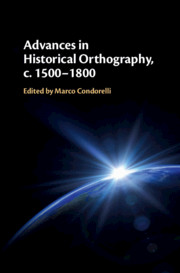Book contents
- Advances in Historical Orthography, c. 1500–1800
- Advances in Historical Orthography, c. 1500–1800
- Copyright page
- Contents
- Figures
- Tables
- Contributors
- 1 From the Early Modern Era to an International Research Area
- 2 A Phonological–Graphemic Approach to the Investigation of Spelling Functionality, with Reference to Early Modern Polish
- 3 Graphematic Features in Glagolitic and Cyrillic Orthographies
- 4 The Emergence of Sentence-internal Capitalisation in Early New High German
- 5 Punctuation in Sixteenth- and Seventeenth-century French and Spanish Grammars
- 6 Orthographic Variation and Materiality of a Manuscript Pre-standard Lithuanian Spellings in Simonas Daukantas’s ‘History of the Lithuanian Lowlands’ (1831–4)
- 7 Investigating Methods Intra-textual, Inter-textual and Cross-textual Variable Analyses
- 8 Orthography and Group Identity A Comparative Approach to Studying Orthographic Systems in Early Modern Czech Printed and Handwritten Texts (c. 1560‒1710)
- 9 Orthographic Solutions at the Onset of Early Modern Croatian
- 10 Women’s Spelling in Early Modern English
- 11 Towards a Relativity of Spelling Change
- 12 Synergic Dialogue in Historical Orthography National Philologies, Comparability and Questions for the Future
- Bibliography
- Index
3 - Graphematic Features in Glagolitic and Cyrillic Orthographies
A Contribution to the Typological Model of Biscriptality
Published online by Cambridge University Press: 02 November 2020
- Advances in Historical Orthography, c. 1500–1800
- Advances in Historical Orthography, c. 1500–1800
- Copyright page
- Contents
- Figures
- Tables
- Contributors
- 1 From the Early Modern Era to an International Research Area
- 2 A Phonological–Graphemic Approach to the Investigation of Spelling Functionality, with Reference to Early Modern Polish
- 3 Graphematic Features in Glagolitic and Cyrillic Orthographies
- 4 The Emergence of Sentence-internal Capitalisation in Early New High German
- 5 Punctuation in Sixteenth- and Seventeenth-century French and Spanish Grammars
- 6 Orthographic Variation and Materiality of a Manuscript Pre-standard Lithuanian Spellings in Simonas Daukantas’s ‘History of the Lithuanian Lowlands’ (1831–4)
- 7 Investigating Methods Intra-textual, Inter-textual and Cross-textual Variable Analyses
- 8 Orthography and Group Identity A Comparative Approach to Studying Orthographic Systems in Early Modern Czech Printed and Handwritten Texts (c. 1560‒1710)
- 9 Orthographic Solutions at the Onset of Early Modern Croatian
- 10 Women’s Spelling in Early Modern English
- 11 Towards a Relativity of Spelling Change
- 12 Synergic Dialogue in Historical Orthography National Philologies, Comparability and Questions for the Future
- Bibliography
- Index
Summary
This chapter engages with the typological model of biscriptality recently developed by Bunčić et al. in order to offer an innovative approach to the analysis of graphematic features in Church Slavonic orthography. In the chapter, the biscriptality model is applied to two South Slavic New Testament texts printed in Glagolitic and Cyrillic letters in 1562/63 and 1563, respectively, in Urach near Tübingen. Through a detailed analysis of some important features of the printed texts of the New Testament, concepts such as letters, graphemes and allographs are used to characterise both the internal script contexts within the two texts and their external biscriptal relations. The chapter outlines a model for biscriptal isomorphism that is applied to six grapheme classes: the segmental graphemes letters and numerals, and the supragraphemes capitalisation, superposition, abbreviation and ligature.
- Type
- Chapter
- Information
- Advances in Historical Orthography, c. 1500–1800 , pp. 46 - 66Publisher: Cambridge University PressPrint publication year: 2020
- 1
- Cited by

